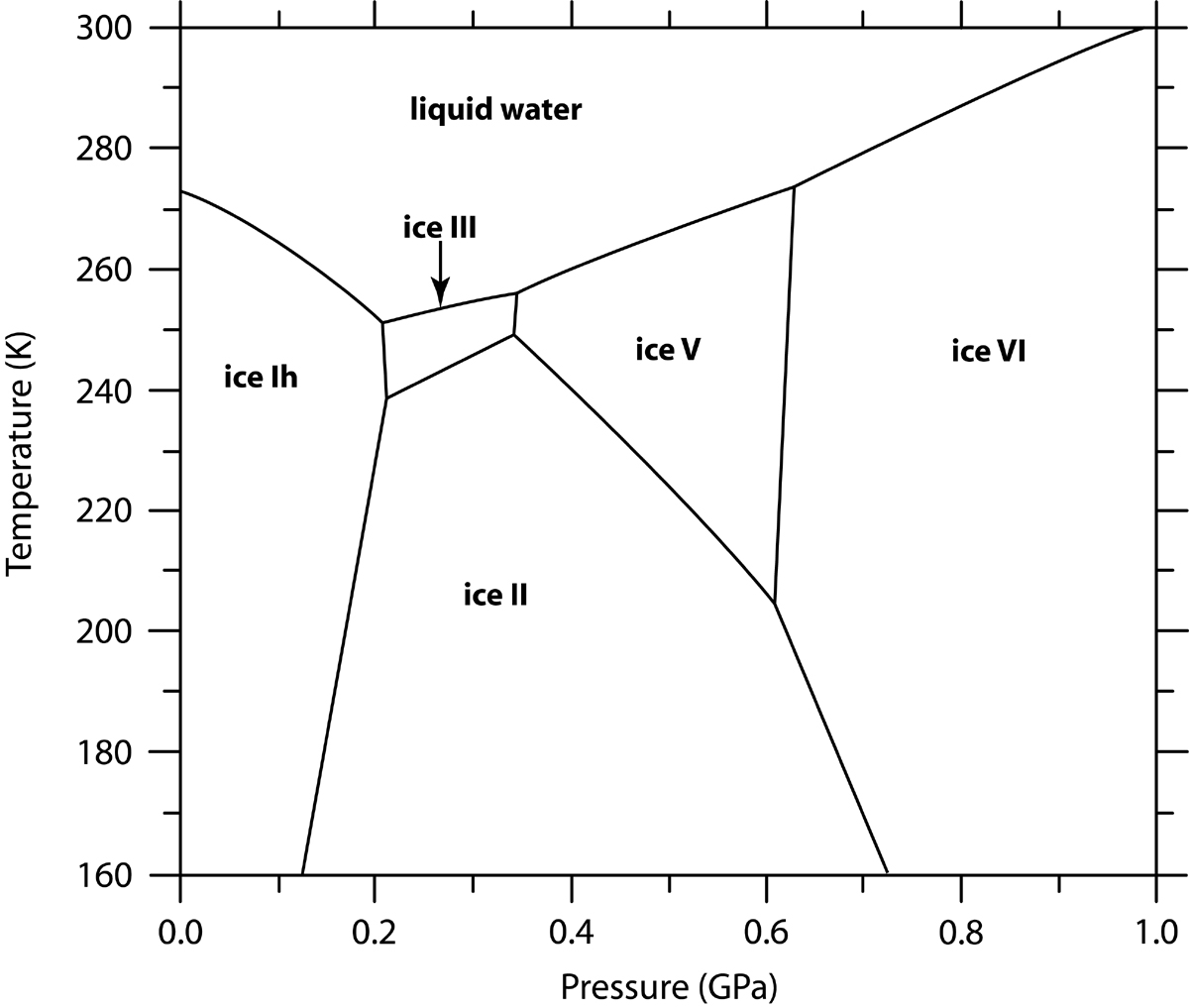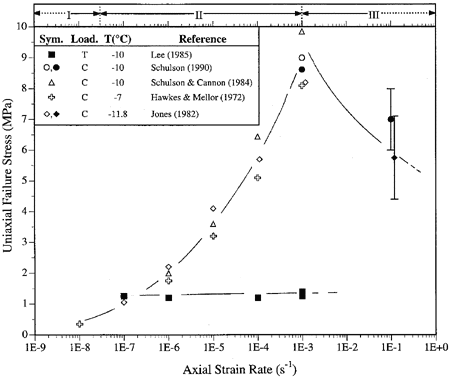We would have to know more about the ice we want to build the wall with.
For example, for ice in icesheets, you have an ice which effectively reaches a plastic region of the stress strain curve at around $0,5 MPa$. I am not a geologist, but I believe that the glaciers can be only thicker than $\sim 50 m$ thanks to it's specific shape and the fact that the surroundings press the glacier back and don't let it crumble (mostly). This would not be the case of a narrow wall, where already at $50 m$ the ice from a natural ice-sheet would crumble away before reaching plasticity (I have a feeling the plasticity will not be caused purely by microscopical structure breakdown but also mesoscopic ice grains breaking each other and moving around).
This study of the US geological survey assesses pragmatically "the crushing strength" of ice and finds that the best ice you find in nature at an ideal temperature has a lower crushing bound at about $\sim 400 \, pounds/inches^2 = 2,8 MPa$.
As Jaime already stated, the main issue is the very lowest bit of the ice carrying the pressure of the whole column above it. This pressure is
$$P=\rho h g \approx 1000 kg \cdot m^{-3} \cdot 200 m \cdot 10 m\cdot s{-2} = 2 MPa \, .$$
So, if you do not take just any ice, but optimalize it's properties, you should be able to build wall of any thickness up to the height of $200m$.
But our intuition is rightly not satisfied with the vision of the mighty wall of ice with the thickness of a paper sheet. Such a wall would obviously tip over with the slightest blow of air, not to mention a giant riding a mammoth from far north Beyond the Wall. (I assume it is no accident the height is same as the one of the Wall from Game of Thrones :)
It is obvious that a thicker wall makes it less prone to being made a hole into, but let us concentrate on the issue of stability. First, the mere fact that a thicker wall is heavier makes it harder to tip over to a critical angle where the wall falls on it's own. Second, the larger base causes that the tipping angle is much higher and the beginning torque to start tipping it of is much larger. If you draw a scheme of the wall with a thickness $d$ and a height $l$, it is easy to show that for the tipping angle $\alpha_t$ we have
$$tan(\alpha_t) = \frac{d/2}{h/2} \to \alpha_t = arctan \left( \frac{d}{h} \right) \,.$$
Or, the tipping angle $\alpha_t$ is always growing with the ratio $d/h$. Furthermore, the initial torque needed to even start tipping of the wall is also growing with the thickness of the wall. The initial torque $\tau$ would have to be
$$\tau = F_{proj} l \,, $$
where $l = \sqrt{(d/2)^2 + (h/2)^2}$ is the distance to the lower edge of the wall from the center of mass and the $F_{proj} = M g d/l$ is the part og the weight of the wall with mass $M$ perpendicular to length $l$. The torque required to even start to tip the wall over then is
$$\tau = Mgd \,.$$
So the torque required to tip the wall is simply proportional both to the mass of the wall and the thickness. Considering the fact that the mass is also a function of $d$, we have an even steeper growth of stability of our wall with it's thickness.
But beware! The edge over which the wall would be tipping reaches virtually infinite pressure in the process of the tipping. This is a consequence of the fact that the very lower part of the edge over which we are tipping the wall is carrying the weight of the whole wall. We must thus build the wall so that the required $\tau$ to even start tipping it is never reached by an intruder. You do not even have to use so much ice - the tipping base is made effectively larger e.g. by slightly curving the wall around.
Even if we ensure a large enough base, we must be sure the intruder actually does not exert enough pressure to start crumbling the lower edges of the wall. For example, a very brutal gust such as the one detected in Australia could exert a dynamical pressure of roughly $0.9 MPa$. This blow would be surely fatal, but even weaker ones could crumble the wall due to inhomogeneities and uneven distribution of pressure.
Overall, the $700 ft \sim 200 m$ tall Wall from Game of Thrones is just slightly unrealistic. It is hardly imaginable that the technology and coordination of that time would be able to create such consistently ideal ice as we were considering up to now. If anything, my best guess would be an estimate of an overall maximal pressure $\sim 2 MPa$ leading to say a $100 m$ tall stable wall. Taking into account that even stone structures in the medieval ages such as cathedrals were never higher than around $160 m$, even the $100 m$ wall from ice would be formidable. Obviously, Physics is loosing breath here, reasoning requires that Magic had to be involved.


 Attribution:
Original uploader was Ivrienen at en.wikipedia - Transferred from en.wikipedia; transferred to Commons by
Attribution:
Original uploader was Ivrienen at en.wikipedia - Transferred from en.wikipedia; transferred to Commons by 